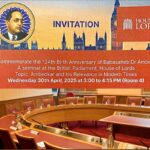
[1:] I have dealt with those, those who are outside your group [=the Mandal] and whose hostility to your ideal [= the destruction of Caste] is quite open. There appear to be others who are neither without you nor with you. I was hesitating whether I should deal with their point of view. But on further consideration I have come to the conclusion that I must, and that for two reasons. Firstly, their attitude to the problem of caste is not merely an attitude of neutrality, but is an attitude of armed neutrality. Secondly, they probably represent a considerable body of people. Of these, there is one set which finds nothing peculiar nor odious in the Caste System of the Hindus. Such Hindus cite the case of Muslims, Sikhs, and Christians, and find comfort in the fact that they too have castes amongst them.
[2:] In considering this question, you must at the outset bear in mind that nowhere is human society one single whole. It is always plural. In the world of action, the individual is one limit and society the other. Between them lie all sorts of associative arrangements of lesser and larger scope—families, friendships, co-operative associations, business combines, political parties, bands of thieves and robbers. These small groups are usually firmly welded together, and are often as exclusive as castes. They have a narrow and intensive code, which is often anti-social. This is true of every society, in Europe as well as in Asia. The question to be asked in determining whether a given society is an ideal society is not whether there are groups in it, because groups exist in all societies.
[3:] The questions to be asked in determining what is an ideal society are: How numerous and varied are the interests which are consciously shared by the groups? How full and free is the interplay with other forms of associations? Are the forces that separate groups and classes more numerous than the forces that unite them? What social significance is attached to this group life? Is its exclusiveness a matter of custom and convenience, or is it a matter of religion? It is in the light of these questions that one must decide whether caste among Non-Hindus is the same as Caste among Hindus.
[4:] If we apply these considerations to castes among Mohammedans, Sikhs, and Christians on the one hand, and to castes among Hindus on the other, you will find that caste among Non-Hindus is fundamentally different from caste among Hindus. First, the ties which consciously make the Hindus hold together are non-existent, while among Non-Hindus there are many that hold them together. The strength of a society depends upon the presence of points of contact, possibilities of interaction, between different groups which exist in it. These are what Carlyle calls “organic filaments”— i.e., the elastic threads which help to bring the disintegrating elements together and to reunite them. There is no integrating force among the Hindus to counteract the disintegration caused by caste. While among the Non-Hindus there are plenty of these organic filaments which bind them together.
[5:] Again it must be borne in mind that although there are castes among Non-Hindus, as there are among Hindus, caste has not the same social significance for Non-Hindus as it has for Hindus. Ask a Mohammedan or a Sikh who he is. He tells you that he is a Mohammedan or a Sikh, as the case may be. He does not tell you his caste, although he has one; and you are satisfied with his answer. When he tells you that he is a Muslim, you do not proceed to ask him whether he is a Shiya or a Suni; Sheikh or Saiyad; Khatik or Pinjari. When he tells you he is a Sikh, you do not ask him whether he is Jat or Roda, Mazbi or Ramdasi. But you are not satisfied, if a person tells you that he is a Hindu. You feel bound to inquire into his caste. Why? Because so essential is caste in the case of a Hindu, that without knowing it you do not feel sure what sort of a being he is.
[6:] That caste has not the same social significance among Non-Hindus as it has among Hindus is clear, if you take into consideration the consequences which follow breach of caste. There may be castes among Sikhs and Mohammedans, but the Sikhs and the Mohammedans will not outcast a Sikh or a Mohammedan if he broke his caste. Indeed, the very idea of excommunication is foreign to the Sikhs and the Mohammedans. But with the Hindus the case is entirely different. A Hindu is sure to be outcasted if he broke caste. This shows the difference in the social significance of caste to Hindus and Non-Hindus. This is the second point of difference.
[7:] But there is also a third and a more important one. Caste among the non-Hindus has no religious consecration; but among the Hindus most decidedly it has. Among the Non-Hindus, caste is only a practice, not a sacred institution. They did not originate it. With them it is only a survival. They do not regard caste as a religious dogma. Religion compels the Hindus to treat isolation and segregation of castes as a virtue. Religion does not compel the Non-Hindus to take the same attitude towards caste. If Hindus wish to break caste, their religion will come in their way. But it will not be so in the case
of Non-Hindus. It is, therefore, a dangerous delusion to take comfort in the mere existence of caste among Non-Hindus, without caring to know what place caste occupies in their life and whether there are other “organic filaments” which subordinate the feeling of caste to the feeling of community. The sooner the Hindus are cured of this delusion, the better.
[8:] The other set [of “neutral” Hindus] denies that caste presents any problem at all for the Hindus to consider. Such Hindus seek comfort in the view that the Hindus have survived, and take this as a proof of their fitness to survive. This point of view is well expressed by Prof. S. Radhakrishnan in his Hindu View of Life. Referring to Hinduism he says,
“The civilization itself has not been a short-lived one. Its historic records date back for over four thousand years and even then it had reached a stage of civilization which has continued its unbroken, though
at times slow and static, course until the present day. It has stood the stress and strain of more than four or five millenniums of spiritual thought and experience. Though peoples of different races and cultures
have been pouring into India from the dawn of History, Hinduism has been able to maintain its supremacy and even the proselytising creeds backed by political power have not been able to coerce the large majority ofHindus to their views. The Hindu culture possesses some vitality which seems to be denied to some other more forceful currents. It is no more necessary to dissect Hinduism than to open a tree to see whether the sap still runs.”
The name of Prof. Radhakrishnan is big enough to invest with profundity whatever he says, and impress the minds of his readers. But I must not hesitate to speak out my mind. For I fear that his statement may become the basis of a vicious argument that the fact of survival is proof of fitness to survive.
[9:] It seems to me that the question is not whether a community lives or dies; the question is on what plane does it live. There are different modes of survival. But not all are equally honourable. For an individual as well as for a society, there is a gulf between merely living, and living worthily. To fight in a battle and to live in glory is one mode. To beat a retreat, to surrender, and to live the life of a captive is also a mode of survival. It is useless for a Hindu to take comfort in the fact that he and his people have survived. What he must consider is, what is the quality of their survival. If he does that, I am sure he will cease to take pride in the mere fact of survival. A Hindu’s life has been a life of continuous defeat, and what appears to him to be life everlasting is not living everlastingly, but is really a life which is perishing everlastingly. It is a mode of survival of which every right-minded Hindu who is not afraid to own up to the truth will feel ashamed.




